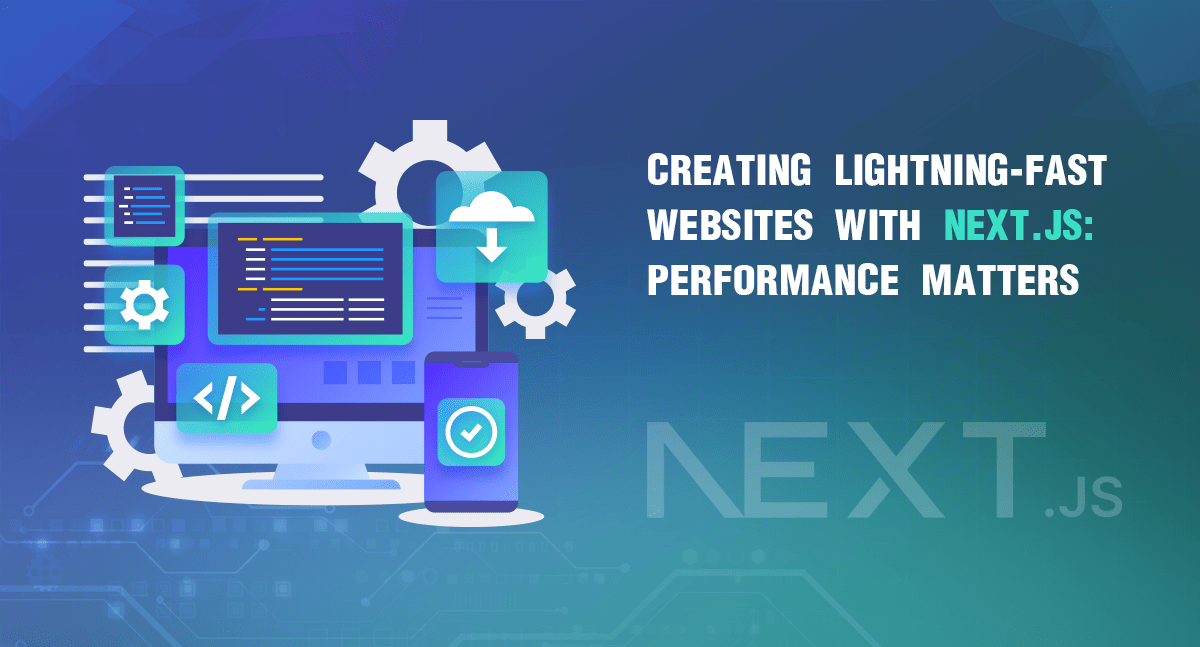Creating Lightning-Fast Websites with Next.js: Performance Matters

Creating Lightning-Fast Websites with Next.js: Performance Matters
Are you tired of waiting for web pages to load, only to be met with frustratingly slow performance? Picture this: you're searching for a product online, eager to make a purchase. But as the seconds pass by, your patience wears thin. Eventually, you give up and move on to a faster site, abandoning the sluggish page behind.
In today's fast-paced digital world, where information is readily available, slow websites can significantly impact your online presence. However, there's no need to worry! This blog will explore the realm of Next.js and unveil how you can effortlessly create exceptionally fast websites that captivate and satisfy your visitors.
Join us on a fascinating journey as we delve into the power of the Next.js development service, exploring its potential to enhance website performance. Throughout this exploration, we will emphasize the significance of delivering an impeccable user experience and unveil proven techniques and best practices for achieving ultra-fast load times. By the end of this blog, you will possess valuable insights to revolutionize your online presence and outshine your competitors.
The importance of website performance
In today's fast-paced digital world, where attention spans are shorter than ever, a website's performance plays a critical role in achieving online success. Slow-loading websites have a detrimental impact on user experience and negatively affect search engine rankings and, ultimately, your business's profitability. This article will delve into the significance of website performance and emphasize why prioritizing it is essential for any business.
- User Experience: A seamless and frictionless user experience is crucial in maintaining visitor engagement and converting them into loyal customers. Research indicates that users have high expectations for website loading times, desiring fast performance within a few seconds. Any delays exceeding this window can lead to frustration and site abandonment. Slow page load speeds contribute to higher bounce rates, reduced time spent on the site, and lower conversion rates. Conversely, a fast-loading website enhances user satisfaction, fosters interaction, and ultimately strengthens customer retention and brand loyalty.
- Search Engine Rankings: Search engines, like Google, prioritize website performance when determining their rankings. A slow site repels potential visitors and indicates to search engines that the user experience may be subpar. Consequently, search engines may penalize such sites by downgrading their rankings. Conversely, a fast-loading website conveys to search engines that it offers a superior user experience, leading to higher rankings and increased visibility.
- Mobile Optimization: In today's mobile-centric world, optimizing your website for mobile performance is crucial, given that most Internet users access websites through mobile devices. Frustrating users who expect quick access to information on the go, slow-loading mobile sites can pose a significant issue. To emphasize the importance further, Google has introduced mobile-first indexing, making mobile website performance a critical factor in search rankings. By ensuring that your website is fast and responsive on mobile devices, you reach a larger audience and increase your chances of success.
- Conversion Rates and Revenue: Website performance directly impacts conversion rates and revenue. Numerous studies have consistently shown that even a mere one-second delay in webpage load time can cause a significant decline in conversion rates. Slow-loading websites discourage potential customers from making purchases and leave a negative impression that hinders future conversions. On the other hand, fast-loading websites provide a seamless browsing experience, instill trust in your brand, and increase the likelihood of visitors becoming paying customers. By optimizing website performance, you can achieve higher conversion rates, increased sales, and ultimately enhance your bottom line.
Understanding the basics of Next.js
Next.js is a robust framework renowned for constructing contemporary and high-performing websites. By harnessing the power of server-side rendering (SSR) and static site generation (SSG), Next.js provides notable advantages in speed and performance. This section delves into Next.js's fundamental concepts and features of Next.js that establish it as an optimal choice for developing lightning-fast websites.
- Server-side Rendering (SSR): Server-side rendering is a technique that involves generating web pages on the server and delivering them to the client as complete HTML documents. Next.js, by default, employs server-side rendering (SSR), which significantly enhances the initial page load speed due to pre-rendering by the server. This approach boosts performance by reducing loading times and facilitates smooth indexing of your pages for search engines.
- Static Site Generation (SSG): Next.js also provides support for static site generation. With this approach, HTML pages are generated during the build process instead of being requested dynamically. It is especially beneficial for content that remains relatively unchanged, like blog posts, product listings, and marketing pages. Using static site generation (SSG), Next.js creates optimized and pre-rendered HTML files, resulting in faster page loading times and an overall enhanced user experience.
- Hot Module Replacement (HMR): Next.js uses Hot Module Replacement, a development feature that allows instant module replacement without reloading the entire page. This feature greatly speeds up the development process by enabling developers to see changes in real-time, eliminating the need for manual browser refreshing. HMR ensures faster iteration cycles and creates a seamless development experience.
- Code Splitting: Next.js utilizes automatic code splitting, which enables the division of JavaScript into smaller chunks that are only loaded when necessary. This optimization technique improves performance by reducing the initial loading time and enhancing the time-to-interactive (TTI) metric. By selectively loading essential components, code splitting ensures a seamless and expedited user experience.
- Automatic Image Optimization: Next.js comes with a convenient image optimization feature that enables you to effortlessly deliver top-notch images while keeping your file size in check. This functionality automatically adjusts the dimensions and compresses the images based on the user's device and screen size, resulting in lighter web pages and enhanced performance. By employing responsive image techniques, Next.js ensures swift loading times without compromising visual excellence.
Conclusion
Next.js, a widely recognized JavaScript library, is favored by developers for its ability to construct speedy and lightweight websites. Built on the popular ReactJS framework and incorporating cutting-edge web development technologies, Next.js boasts exceptional performance that captivates users. Its lightning-fast website generation significantly reduces load times, enhancing responsiveness and user-friendliness. Additionally, Next.js exhibits remarkable scalability, catering to projects of various sizes. The platform's credibility is further solidified by its proficient team of developers who provide unwavering support in building reliable websites.




